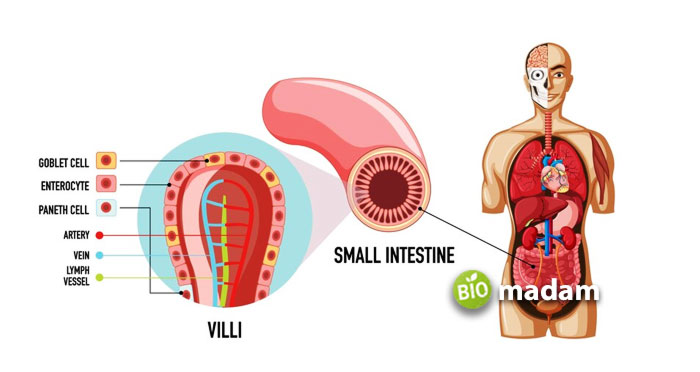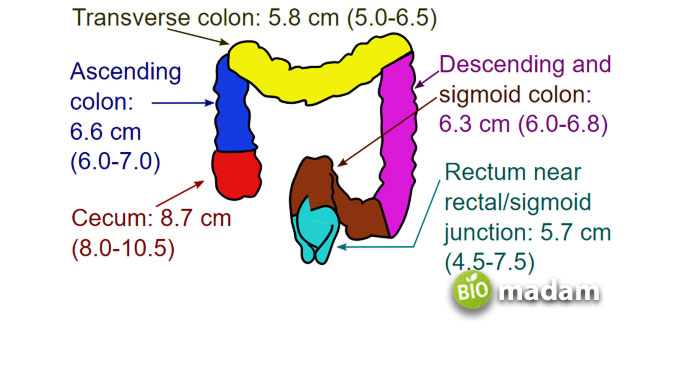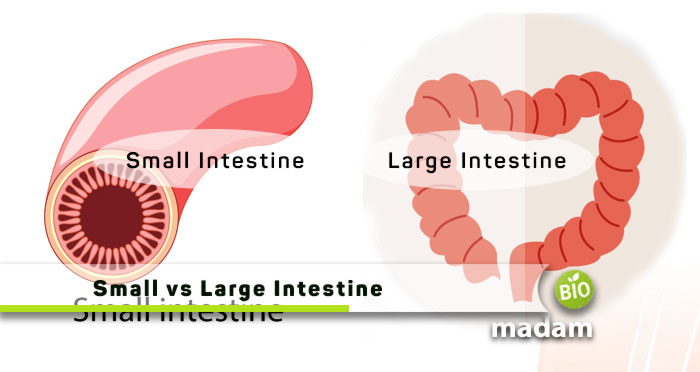Recently updated on March 29th, 2023 at 06:50 am
The intestine is a vital part of the GI system that enables the absorption of micro and macronutrients and water from ingested food. It is present after the stomach and extends to the anus. While it seems like a long compressed tubular structure, it is divided into two main parts – the small intestine and the large intestine. The small and large intestines are interlinked. Yet, they perform specific functions. Here are all the anatomical and physiological differences between small and large intestines for your understanding.
Comparison Table
| Characteristic | Small Intestine | Large Intestine |
| Location | Next to stomach | Present after small intestine |
| Size | 7 m long | 1.5 m long |
| Lumen | 3 – 4 cm | Up to 6 cm |
| Wall | Smooth | Saccular |
| Function | Nutrient absorption | Water absorption |
| Movement | Fast | Slow |
| Hormones | Yes | No |
| Villi | Present | Absent |
| Folds | Circular folds | Absent |
| Teniae Coli | Absent | Present |
| Haustra | Absent | Present |
| Peyers Patches | Present | Absent |
What are Intestines?
The intestines are the fourth part of the digestive system after the buccal cavity, esophagus, and stomach. When the food is churned in the stomach, it passes to the intestines. The small and large intestines absorb nutrients and water from the digested food. Once the leftover is only waste material, it moves to the distant end of the large intestine and excretes out. The small intestine majorly absorbs nutrients from the digested food. Contrarily, the large intestine absorbs water from indigestible residue.
Small Intestine
The small intestine is the largest part of the GIT where most digestion occurs. It is also known as the small bowel. The length of the small intestine is around seven meters. The small intestine majorly contributes to the absorption of nutrients from metabolized food. There is no distinct segregation of the small intestine. Although, duodenum, jejunum, and Ilium are considered three parts of the small intestine.

Duodenum
The duodenum is the first part of the small intestine next to the stomach. It is only 10 inches long. It curves near the pancreas to fit in the abdominal cavity properly. The gallbladder, liver, and pancreas juices facilitate digestion in the duodenum. The food enters the duodenum from the stomach and moves to the jejunum.
Jejunum
The jejunum is the second part of the small intestine that functions to absorb and digest food. It is around 2.5 meters in length and coiled adequately. It gets a deep red color due to numerous blood vessels. Jejunum contributes to physical digestion more than the duodenum. It churns the food, absorbs proteins and carbs, and moves it forward through peristaltic movements. The digestive juices help further the breakdown of the components.
Ilium
Ilium is the last part of the small intestine. It is the longest segment and is almost 3.5 meters in length. It is the primary site of nutrient absorption where the digested food stays for a large time. The food slowly moves to the large intestine through the ileocecal valve.
Large Intestine
The large intestine is the second part of the intestine. It is named the large intestine because of its wider lumen. The length of the large intestine is around 1.5 meters only. The food from the small intestine moves to the large intestine. The water is absorbed here and feces are formed. The wastes leave the body through the last part of the large intestine called the anus. The large intestine consists of the cecum, colon, rectum, and anus. Generally, the term colon is also used for large intestines interchangeably.
Cecum
The cecum is the initial part of the colon where the food enters from the ileocecal valve. The first six inches of the large intestine are the widest. The digested food accumulates in the cecum. When it is full, it triggers bowel movement in the large intestine.
Colon
The next part of the intestine is the colon, where water and electrolytes are absorbed. Absorption takes place in the transverse colon, and dehydrated waste moves to the descending colon. Here it is lubricated with mucus to facilitate excretion as the solid waste is dry. The food moves slowly in the large intestine. The breakdown of carbohydrates from the entire calories takes place meanwhile. The carbohydrates release Vitamins B and K by the action of gut bacteria.
Rectum
The rectum is the last destination of the waste before it passes out of the body. When the food reaches the rectum, it urges the body to defecate.
Anus
The anus is the excretory canal where the faces move out. It has an involuntary internal sphincter that opens when the waste exists in the rectum. The outer sphincter is voluntary in adults and opens when you want to excrete.

Similarities Between Small and Large Intestine
- They are parts of the gastrointestinal tract.
- The small and large intestines are long tube-like structures within the abdominal cavity.
- They both have blood vessels.
- They absorb nutrients and facilitate digestion (less or more).
Differences Between Small and Large Intestine
Definition
Small Intestine
The small intestine is a part of the GIT that helps absorb nutrients from food.
Large Intestine
The large intestine lies next to the small intestine and absorbs water from the digested food.
Location
Small Intestine
The small intestine is present in the abdominal cavity just after the stomach and before the large intestine.
Large Intestine
Whereas the large intestine follows the small intestine and moves to the last part of the GIT, i.e., the anus.
Size
Small Intestine
The small intestine is around 7 meters in length.
Large Intestine
Contrarily, the large intestine is shorter than the small intestine and only 1.5 meters long.
Lumen
Small Intestine
The lumen of the small intestine is narrow, ranging between 3 and 4 cm.
Large Intestine
Although, the large intestine has a wider lumen of up to 6 cm.
Wall
Small Intestine
The small intestine has a smooth wall with hair-like structures, called microvilli.
Large Intestine
On the other hand, the large intestine’s internal wall comprises a sac-like surface, unlike the small intestine.
Function
Small Intestine
The small intestine is majorly involved in the absorption of vitamins, minerals and the chemical digestion of food.
Large Intestine
In contrast, the large intestine absorbs water from the indigestible food waste. It also breaks down carbs to obtain vitamins with the help of gut-friendly bacteria.
Movement
Small Intestine
The small intestine exhibits fast and more frequent churning and peristaltic movements.
Large Intestine
At the same time, the movements in the large intestine are quite slow. The residue stays in the large intestine for a long time.
Hormones
Small Intestine
The small intestine secretes hormones and different enzymes to initiate the digestion of proteins and carbs and their movement.
Large Intestine
Despite this, the large intestine does not secrete hormones.
Villi
Small Intestine
Villi are present in the small intestine to facilitate the absorption of materials.
Large Intestine
Conversely, the large intestine does not have villi or microvilli to promote absorption.
Folds
Small Intestine
The small intestine has circular folds on the internal side.
Large Intestine
However, the large intestine does not contain any circular folds.
Teniae Coli
Small Intestine
The small intestine contains longitudinal muscles in circular layers. Teniae coli are absent.
Large Intestine
But, the longitudinal muscles of the large intestine are arranged in three segments called Teniae coli.
Haustra
Small Intestine
Haustra are absent in the small intestine.
Large Intestine
Alternatively, they are present in the large intestine.
Peyers Patches
Small Intestine
Peyers patches are present in the small intestine.
Large Intestine
Unlike the small intestines, they are absent in the large intestine.
The Bottom Line
The small and large intestines are crucial parts of the gastrointestinal tract. They help further break down the food and absorption of nutrients and water. The small intestine is longer than the large intestine. However, the large intestine has a wider lumen. The food moves from the stomach to the small intestine, where nutrients are absorbed into the bloodstream. The small intestine pushes the digested food to the large intestine. The large intestine absorbs water from the indigestible residue and eliminates it through the anus.
FAQs
What is the function of the small intestine?
The small intestine absorbs essential nutrients from the digested food through villi and microvilli.
What is the function of the large intestine?
The large intestine does not contribute to digestion majorly. It absorbs water from the food residue and pushes the feces to the anus.
What is the length of the small intestine?
The small intestine is the longest part of the gastrointestinal tract. Its length is between 4.5 and 7 meters, coiled within the abdominal cavity.
What is the length of the large intestine?
The length of the large intestine is 1.5 meters. It is shorter than the small intestine.

Anna has completed her degree in Pharmacy from the University of Hawaii. She is serving as a research assistant in a pharmaceutical company. She had a great interest in writing blogs, traveling to different parts of the US, and trying delicious recipes in her spare time.

